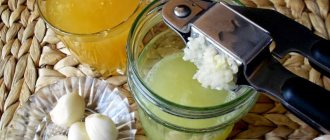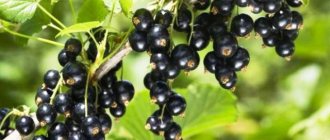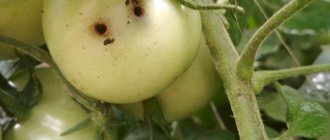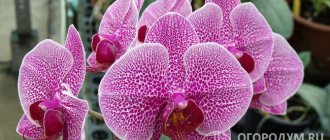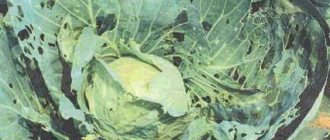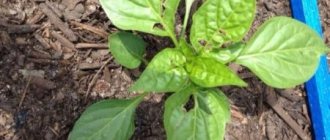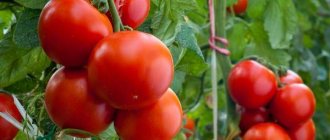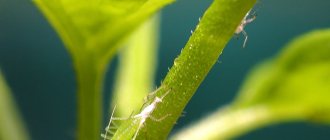With the onset of spring days and the appearance of greenery in garden plots, insect pests wake up and attack young leaves and shoots. Among the worst enemies of currants are aphids. It sucks juices from tender leaves, causing great damage to the plant. To start fighting aphids, you must first detect them.
What is the danger of aphids on currants?
Aphids feed by piercing tender young leaves with their proboscis and sucking out the juice from them. The leaf surfaces become deformed and red-brown swellings appear on them. The leaf dries and dies.
Another type of aphid sucks juices from shoots, preventing their growth. Since young shoots of shrubs are affected, gardeners may lose part of the harvest not only of the current year, but also of the future.
Insects will not destroy the entire bush, but it begins to wither, weaken, and fruiting will be insignificant. In addition, insects are carriers of various viruses that cause diseases.
You can read more information about diseases and pests of currants here.
Signs of defeat
Colonies of aphids settle on the inside of currant foliage; the pest is difficult to notice from afar until it begins destructive activity. Systematic inspection of bushes allows you to identify aphids in the early stages of reproduction.
Signs of aphid damage to a berry bush:
- In the central part of the leaves of red or white currants, swellings appear, gradually acquiring a yellowish, then purplish color, and chlorosis of the veins is observed. A little later, red-brown growths appear on young shoots. Such manifestations are typical when a plant is infected with colonies of gall aphids.
- When black currants are infected by the gooseberry variety of aphids, the leaves curl into a tube, the tops of the shoots take the shape of a ball or cocoon, where the pest feeds and reproduces. Young shoots stop growing and their deformation and curvature are noticeable.
- Subtle punctures left by harmful insects appear on the surface of the leaves.
- In the currant branches you can see ants - insect partners of aphids that participate in its spread.
In advanced cases, large accumulations of adult aphids and larvae of aphids are found on the inside of the foliage.
What aphid attacks currants?
Despite the many types of pests, currants are parasitized by two of them: gall aphids and gooseberry aphids. Read about them in detail below.
Gall aphid (leaf)
The gall (leaf) aphid, or redcurrant aphid, as its name suggests, prefers shrubs with white or red berries. This is due to the fact that the foliage of these species is more delicate, the leaf surface is thinner, which allows pests to easily pierce the leaf, pumping out the juices from it.
Brown thickenings and galls appear on the damaged area. This is how the plant tries to heal. If you turn over such a leaf, you can see many small insects under it.
This type of pest lives wherever red currants grow. The gall aphid has an oval body, slightly more than 2 ml long, with small hairs. The color is pale green.
Most insects are wingless. Females are very fertile, hatching from eggs in the spring, and on the second day of life they are ready to reproduce. Being viviparous, they produce up to hundreds of new aphids.
Hot and dry summers contribute to the active spread of the pest. Winged forms of pests appear when it is necessary to colonize another place after the destruction of the previous one.
Gooseberry aphid (shoot)
Gooseberry aphid (shoot aphid) lives on black currants and gooseberries. This is a very numerous, prolific species. The insects are small, about 2 ml in length, greenish in color.
They feed on the juice of leaves and young twigs, accumulating on their tops, causing the leaves to curl, forming spherical lumps or cocoons. The branch stops growing, inside the damaged leaves there is a colony that is actively feeding and reproducing.
Females have a winged shape, which makes pest control difficult. New generations of aphids can destroy the entire garden, flying from bush to bush, especially in dry, hot weather.
Pest control methods
Treat currants against aphids in the morning or evening, in dry, windless weather. When working with chemicals and caustic agents, wear a respirator, gloves and goggles.
Aphids of any type live in symbiosis with ants, which are attracted to the liquid secreted by the insects - milk. Ants love to “milk” adult individuals, so they protect their settlements, move them to new places, and even drag them underground to hibernate. If you want to completely destroy aphids, exterminate garden ants.
Gardeners and summer residents have in their arsenal many methods and techniques to combat this annoying pest. In addition to proven folk remedies, there are many chemicals that destroy the enemy of berry bushes.
Chemicals
When aphids have attacked in large numbers, all traditional methods have been tried, and there is no time to make decoctions and infusions, chemicals will come to the rescue. Modern insecticides are presented in stores in a wide range.
Among them are:
- Aktellik;
- Aktara;
- Biotlin;
- Spark double effect;
- Intavir;
- Kalash;
- Karbofos;
- Fufanon et al.
Each product has its own instructions for use, which must be strictly followed. It is recommended to pay special attention to the timing of application.
It is strictly forbidden to use chemicals during the fruiting period and to collect berries no earlier than 20-30 days after spraying the chemicals. You should work in protective clothing, a respirator, and goggles.
The use of chemicals poses a threat of poisoning to beneficial insects, birds, and domestic animals. Before starting work, weigh all the risks and make the best choice. Despite strict restrictions, pesticides have a quick effect - the aphids die almost immediately.
Biological drugs
Fruiting begins, and the currant bushes are swarming with aphids. For such cases, modern biological drugs are acceptable. They do not harm plants, are safe for humans, and are produced on the basis of soil organisms. The most common:
- Aktofit;
- Biotlin;
- Spark bio;
- Fitoverm.
Such drugs do not work immediately. The aphids, eating them, slowly die. Use biological products according to the included instructions. Precipitation washes away the biological product, so repeat the treatment after rain. Harvest berries 5 days after treatment.
In this video, an experienced gardener talks about the varieties of aphids that parasitize currants, and also gives recommendations on how to combat them using biological products:
Folk remedies
Fans of organic farming and gardening use biological means. Let's consider different types and methods of destroying aphids, both gall and gooseberry.
Plucking and destroying affected leaves
In the spring, when young branches began to grow on the bushes, and curling appeared on their tops - the result of the work of aphids, so feel free to tear off the damaged leaves. The bush will not be harmed.
At the site where the leaves are torn from the axils, new shoots will appear, which will give a bountiful harvest. In this way you will form the crown of the bush and destroy pests. Don't forget to burn the torn leaves.
Flush with water
Simply direct a strong stream of water from a garden hose at the bush. Under its pressure, insects will fall off the leaves. The method is simple, but requires daily inspection of plants and repeated application.
The effectiveness is insignificant, since the aphids hide in the folds of the leaves, and the twisted cocoons do not break through with water. The presence of ants will reduce the method to zero, as they will quickly return their “herd” to their place.
Boiling water
In early spring, before the buds swell and the leaves bloom, it is useful to pour boiling water over the entire bush. As soon as the water boils, pour it into a shallow watering can or sprayer and water the crown of the plant.
Don't worry, hot water won't harm the branches. It will get under the bark and destroy the nests of pest eggs. After dousing, do not forget to whitewash the trunks with lime, which will continue to kill insects.
Ammonia
Ammonia or 10% ammonia solution is a very reliable, safe and simple way to combat aphids.
Prepare a solution for spraying:
- Dissolve 40 g of soap (laundry, tar, etc.) or 2-3 tbsp in 10 liters of warm water. l. liquid green soap, as well as any detergent. Soap is needed for better adhesion of the solution to the plant.
- Add 30-40 ml of ammonia.
- Mix the resulting solution well and spray the currants thoroughly. Wear gloves as the leaves need to be turned over and curled leaves unrolled.
- Spray not only the infected branches, but the entire bush to prevent insects from crawling.
Such a shower is an additional nitrogen fertilizer. Berry plants can be sprayed with ammonia solution during the fruiting period; it is harmless.
Watch a video about treating currants against aphids with ammonia:
Baking soda
Sodium bicarbonate will help control aphid colonies. To prepare the solution, take 2 tbsp. l. baking soda per 1 liter of warm soap solution prepared in advance.
Grate laundry soap (30-40 g per 10 liters of water), so it will dissolve better in water. Spray currant bushes with the resulting product in early spring, before the buds open.
Soda irritates the surface of the body of insects and corrodes their shell. They try to escape from the spraying site, but the soap solution interferes with them. In this way, the desired therapeutic effect is achieved.
Before spraying, you can wash the leaves manually with a soda solution.
Laundry soap
Laundry soap has long been used to kill various plant pests. Preparing a soap solution is not at all difficult:
- For 10 liters of water, take 1.5 pieces of soap. Grate it, stir in 1-2 liters of warm water until completely dissolved.
- Then pour it into a bucket with the rest of the water. The solution is ready.
- To use in spray bottles, strain through cheesecloth.
- You can use liquid laundry soap. It will require 125 g per 10 liters.
Use a simple soap composition if aphids have just appeared on the bushes. If there are a large number of pests, soap alone will not be enough.
Infusion of potato tops and leaves
This king of cottages and vegetable gardens belongs to the nightshade family; its leaves and tops contain corned beef and are therefore poisonous. Summer residents and gardeners know this, so they use an infusion of potato greens as a pest repellent.
To prepare the strongest poison for aphids, take about 1 kg of potato tops and leaves, chop them, pour 10 liters of boiling water. Leave for 2-3 days, strain and spray the bushes.
Do not spray in bright sunlight to avoid leaf burns. The problem is that aphids appear before the tops grow. Therefore, experienced gardeners harvest it at the end of summer, dry it in a dark, dry place and store it until the next season.
Onion infusion
Prepare onion infusion as follows:
- Chop 100 g of onion.
- Add 200 g of onion peels.
- Pour 10 liters of hot water and leave for 4-5 days.
- After straining, spray the bushes.
Repeat the treatment 3 times at weekly intervals. You can use green onions, but you will need 2-3 kg per 10 liters of water. Leave for 4-5 days. When treating bushes, try to spray the underside of the leaves.
Tomato tops
The harmful effects of tomato leaves on pests are due to the presence of solanine, a toxic substance, in them. When leaves and shoots grow on tomatoes, experienced gardeners do not throw them away when cutting them, but use them in the form of decoctions for spraying fruit bushes.
Prepare a decoction according to the following recipe:
- Take 4 kg of chopped tomato tops and fill it with 10 liters of water.
- After 3-4 hours, put on fire and cook for 30 minutes, covering with a lid.
- When the broth has cooled, strain.
- Before treating the plantings, dilute the finished concentrate with water 1:4.
You can use dried tops; you will need 1 kg per 10 liters of water. But dry tops should not be stored for a long time. It is better to place it under currants and other bushes to repel insects.
Onion peel
This option is well suited when you need to carry out urgent processing of plantings. The infusion is prepared quickly and easily. Take 200 g of onion peel, pour 10 liters of warm water, strain after 12-15 hours.
The infusion is ready, spray the infected branches with it without diluting. Collect onion peels in advance during the winter.
Garlic infusion
Another powerful remedy against small pests. Chop 200 g of garlic, add a liter of water and leave for 3-5 days.
The infusion is so strong that you only need 50 ml per bucket of water. Spray the currant bushes completely with it, wetting all the leaves, especially the lower part.
Celandine
The grassy weed growing along roads, on river banks, and on the slopes of ravines is familiar to everyone. Its bright flowers are visible from afar. And the yellow juice released by the broken stem leaves brown marks on the hands.
Celandine is an excellent insecticide in the fight against aphids:
- Prepare a decoction of 4 kg of chopped greens of this weed (the whole plant will go) and 10 liters of water.
- Leave for 3-4 hours.
- The liquid will turn dark brown. Strain and process the bushes, watering generously with the infusion until moistened. Wear gloves!
The video below shows a method of pest control using celandine:
Soda Ash
A calcium-fortified version of soda. The method of application differs only in proportions. You will need 1 tbsp. l. soda ash per 1 liter of soap solution.
The presence of calcium provides plants with additional nutrition and increases their resistance to disease. It is indispensable in the fight against powdery mildew and gray rot, and is needed to restore leaves.
Iodine can be added to the solution. For 10 liters of water, take 2 tbsp. l. soda, 1 tsp. iodine and 40 g of laundry soap or 2 tbsp. l. liquid. The addition of iodine improves currant disease resistance.
Spray with soda solution before and during flowering, but not more than once every 2 weeks.
Laundry soap and wood ash
Ash is an excellent complex alkaline fertilizer, as it contains all the nutrients necessary for plants. A decoction of wood ash will help get rid of various pests, including aphids:
- Take 300-400 g of sifted ash, pour 10 liters of water and boil for 20 minutes.
- Cool, then strain through several layers of cheesecloth so as not to ruin the garden sprayer.
- Add 2 tbsp. spoons of liquid green or 30-40 g of grated laundry soap. Stir.
- Process the currant bushes without missing a single leaf.
- Repeat the procedure 2-3 more times for prevention.
Repellent plants
Many gardeners and summer residents successfully use the insecticidal properties of plants in their gardens. In addition to the already mentioned potatoes, tomatoes and celandine, the property of strong-smelling flowers to repel insects is widely known.
Plant lavender, marigolds, calendula or marigolds, saffrons, and pyrethrum chamomile around the currants. Sow yarrow, wormwood, or at least place branches of these plants under the bushes.
You can use tomato tops and garlic leaves. Onions, thyme, and garlic planted near bushes will be excellent neighbors. When the black elderberry blooms, cut off its flowering branches and place them directly on the currant bush. Or make bouquets of it and place it under the bushes.
Aphids cannot tolerate strong odors.
Biological enemies
Since aphids are very weak insects, they have many enemies among predatory insects. Its main enemy is the ladybug beetle, whose larvae massively eat the aphid itself and its larvae.
These bright bugs often settle in gardens and summer cottages. Try not to use chemical pesticides that kill not only pests, but also beneficial insects.
Scented plants planted next to them, which at the same time work as aphid repellers, will help attract ladybugs to currant thickets. To prevent the beetles from flying away, add additional food - mix yeast with sugar in equal proportions and add a little water. You can collect ladybugs in the meadow and transfer them to the currants.
At night, aphids are attacked by lacewings, small elongated insects with transparent mesh wings. To attract them, plant cumin and tansy next to the berry bushes.
Fumigation of currants
A very interesting way to combat aphids. It should be applied in early spring, before the leaves bloom. Make a fumigator from an old tin can - just nail the can to a long stick.
Take pieces of rubber, old tires will do, place them in a jar, set them on fire and smoke all the currant branches one by one. Do not bring the fumigator close to the branches so that the flame does not burn them.
Make sure that only smoke reaches the branches, which will kill all aphids and microbes. Careful, leisurely fumigation is guaranteed to rid you of annoying insects.
Hot pepper
Pour crushed hot pepper pods with water in a ratio of 1:10, boil for 30 minutes. After 2 days, strain. The infusion is very spicy, so dilute it: 100 ml per 1 liter of water.
It turned out to be a good aphid repellent. Treat all currant bushes with it, even those that are not infected. Pepper decoction can be prepared for future use:
- Take 1 kg of pods, cut in half.
- Simmer over low heat for an hour. Don't forget to close the lid.
- Leave for 2 days, strain, bottle, close tightly and store in a dark place.
To work, dilute 500 g of decoction in 10 liters of water, add 40 g of laundry soap. After such spraying, the aphids will have no chance of survival.
Preventive measures
Preventive measures The
following is practiced as prevention:
- regular inspection of leaves;
- use of fertilizers with low nitrogen content;
- thorough weeding and mulching;
- fighting ants;
- pruning dry branches and removing old bark;
- loosening the soil and whitewashing the trunks in the fall.
To destroy aphids, you must use all available means. Modern technologies will help save time and effort. Home methods will eliminate any harmful effects on the future harvest. When treating currants against aphids with chemicals, personal protective equipment is worn - gloves, goggles, respirators.
Spraying of bushes is carried out in the evening in dry, windless weather. In case of rain, repeat everything. Particular attention is paid to young currant shoots and the lower part of the leaf.
They get rid of ants on the site: aphids live in symbiosis with them. The earthen “hard workers” are attracted by the milky secretion of the pest, and the ants actively protect the “breadwinners”, help migrate and “take” the aphids to spend the winter.
If aphids have chosen cherries, cherry plums, currants and gooseberries, “heavy artillery” is used - chemicals and biological products. There is no point in relying on natural farming.
Aphids are a frequent “guest” in the garden. To prevent the pest from becoming a permanent resident on currants, a triad of measures will help. Spring-autumn prevention of plantings, treatment of diseased bushes, maintaining order on the site. Traditional methods are safe, they often also “feed”, but require consistency. Chemistry is used in case of mass infection of currant plantings, if other methods are unsuccessful.
Now you know how to fight aphids on currants.
Prevention
Fighting aphids is a long and tedious task. To prevent insects from infecting berry gardens, follow these simple rules:
- Perform annual pruning of bushes, removing all damaged branches and shoots.
- Regularly pull out weeds around the bush.
- Dig up the soil under and around bushes.
- Eliminate garden ants.
- Plant aphid repellent plants.
- Let ladybugs and lacewings live in your garden.
- In spring, scald the bushes with boiling water.
- Whitewash trunks and branches.
You have learned ways to combat the currant pest - aphids. Which one to choose is up to you. Practice and experience will help you make the right choice. Fighting aphids is a methodical, responsible and constant activity. Simple preventive measures will help alleviate it.
0
0
Copy link
What are the dangers of chemical treatment?
Chemicals are most effective in controlling aphids, but they also carry a certain danger.
First of all, the use of insecticides during the flowering period is dangerous for bees. This is bad not only in itself, but also from the point of view that pollination will not take place. This means there is a chance to be left without a harvest at all.
Each poison has its own expiration date. If less time passes after processing, harmful substances will still remain in the fruit. There is a considerable chance of getting food poisoning.
In addition, if you prepare an overly concentrated solution, you may simply burn the leaves of the plant.
Dried red currant leaves


